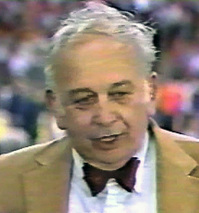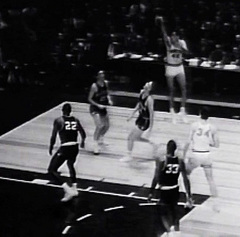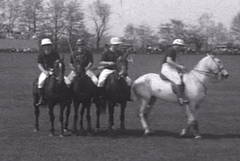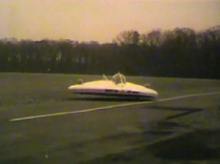Today’s blog is written by Mark F. Bernstein ’83, author of Football: the Ivy League Origins of an American Obsession (2001). A previous entry from him about Princeton football can be found here.
Category Archives: Athletics
Men’s Basketball — Princeton vs. Georgetown, 1989: Who does not like a David versus Goliath matchup?
On March 17, 1989, in the opening round of the NCAA men’s basketball tournament, Princeton University, seeded #16, faced national powerhouse Georgetown University, seeded #1 in the East Region. It was a classic David versus Goliath matchup. Since the tournament was expanded to 64 teams in 1985, a #16 seed has never defeated a #1 seed. There have been some close calls, but none closer than Georgetown’s narrow one point victory over Princeton.
 Princeton, led by their famously colorful coach Pete Carril (left), was 19-8 overall, and as Ivy League champions had earned an automatic bid to the national tournament. They were a young team, with only one junior, Matt Lapin, and one senior, Ivy League Player of the Year and captain Bob Scrabis, on the roster. But, this was also a Princeton team that led the nation in defense, allowing only 53 points per game.
Princeton, led by their famously colorful coach Pete Carril (left), was 19-8 overall, and as Ivy League champions had earned an automatic bid to the national tournament. They were a young team, with only one junior, Matt Lapin, and one senior, Ivy League Player of the Year and captain Bob Scrabis, on the roster. But, this was also a Princeton team that led the nation in defense, allowing only 53 points per game.
Princeton’s Bicentennial: Charter Day, October 19, 1946
In the 1946-1947 academic year, Princeton celebrated its 200th anniversary with a series of convocations and events, ending with a concluding ceremony, captured in a newsreel, which included a convocation address by US President Harry Truman. Today’s blog features another newsreel about the University’s bicentennial year that focuses on “Charter Day,” October 19, 1946. In addition to Princeton’s almost 200-year old charter and the “largest procession in Princeton history” at the time (which included 23 honorary degrees recipients), the newsreel addresses the beginning of intercollegiate football, depicting a re-enactment of the first football game between Princeton and Rutgers from November 6, 1869 during halftime of the 1946 Princeton-Rutgers game.
Princeton’s charter, granted to the University on October 22, 1746 (then still known as the “College of New Jersey”) is shown fleetingly in the newsreel (0:38). Readers of our regular blog already know that the charter, on intermittent display during the celebration of Mudd Manuscript Library’s 50th anniversary, is actually not the original (which was lost) but the second charter, drawn up in 1748. (An explanation can be found in our Frequently Asked Questions.) The famous early picture of Nassau Hall that follows at 0:48 is the copper engraving by Philadelphia artist Henry Dawkins (copied from a drawing by Princeton student William Tennent, Class of 1758), which was printed in Samuel Blair’s Account of the College of New Jersey (1764). For more information about the engraver, who was also a counterfeiter of paper money, see Julie Mellby’s Graphic Arts blog.
Over 500 people comprised the academic procession that opened and closed the morning’s convocation, according to the Prince, including faculty, trustees, representatives of all alumni classes and members of the Undergraduate Council. The procession included an official delegation from the United Nations, headed by Secretary General Trygve Lie, and members from the State Bicentennial Commission, including Walter E. Edge, Governor of New Jersey. Lie (1:42) and Edge (2:11) were among the 23 honorary degree recipients, as were the Danish physicist Niels Bohr, the Spanish writer Salvador De Madariaga, and the French philosopher Jacques Maritain (2:21–not all recipients are clearly visible).
The last eight minutes of the newsreel are occupied by the 38th Rutgers-Princeton football game in the afternoon (2:47), with a humorous reenactment of the first Rutgers-Princeton game of November 6, 1869 (5:51), considered the ‘birth’ of intercollegiate football. A description of the football game and the reenactment by Theatre Intime and members of the Rutgers soccer team can be found in the Prince. A copy of the program notes about the 1869 football game, with an explanation of the rules, may be downloaded at Twenty-four Stalwart Men.pdf. A second article from the program, summarizing the history of the Princeton-Rutgers football rivalry, can be viewed at 77 Years Princeton-Rutgers.pdf. More information about early football can be found in Football: the Ivy League Origins of an American Obsession by Mark Bernstein ’83, who wrote our previous blog entry.
The footage on this 16mm film is part of the University Archives’ Historical Audiovisual Collection (part of item no. 0092).
Post-war Princeton football newsreels (1947-1956)
Today’s blog is written by Mark F. Bernstein ’83, author of Football: the Ivy League Origins of an American Obsession (2001).
“The Year of the Tiger:” the 1964-1965 Basketball Season at Princeton
Princeton’s season opened on December 2nd with an 83-74 victory over Lafayette College. Crowds filled Dillon Gymnasium to watch the team, and as the end of December approached, Princeton was 6-2. Then at New York City’s Madison Square Garden (2:34), where the annual Holiday Festival tournament was played, Princeton opened with a victory over Syracuse. But the match-up everyone was anxious to watch pitted Princeton against the University of Michigan — then the number one ranked team in the country. Michigan’s star player was Cazzie Russell, a versatile 6’ 6” all court player.
 l, Princeton struggled to find its rhythm, but managed to keep things close. With less than a minute to play, they still led by two points. In the waning seconds (6:08), Michigan put the ball in Russell’s hands, and he did not disappoint, nailing the winning shot which gave Michigan an 80-78 victory. It was not the last time that these two teams would meet during the season. Nor would it be the last time that Bradley and Russell would compete together. Both played on New York Knicks teams in the late 1960s. (The Daily Princetonian, January 5, 1965)
l, Princeton struggled to find its rhythm, but managed to keep things close. With less than a minute to play, they still led by two points. In the waning seconds (6:08), Michigan put the ball in Russell’s hands, and he did not disappoint, nailing the winning shot which gave Michigan an 80-78 victory. It was not the last time that these two teams would meet during the season. Nor would it be the last time that Bradley and Russell would compete together. Both played on New York Knicks teams in the late 1960s. (The Daily Princetonian, January 5, 1965)Princeton’s Polo Team and ROTC Field Artillery Brigade in Action! (circa 1928)
The film featured here, shot around 1928, contains three distinct sections. The first contains images of the Princeton Polo Team playing on W. B. Devereux Jr. ’04 Field (0:00-5:52). The second section opens with a woman and a small boy after the polo tournament (5:53-5:58), followed by scenes of Prospect Avenue and the various eating clubs located on this street (5:59-6:45). The third section documents the annual inspection of the Reserve Officers’ Training Corps (ROTC) Field Artillery Unit, performed by representatives of the United States War Department. The origins of the film, which does not appear on the list of films that were kept by the Graduate Council in 1931, are unclear.
Polo at Princeton
Although polo has been around for millennia, the first documented games on Princeton’s campus occurred in 1902, when Walter Bourchier Devereux Jr. ’04 and a few classmates organized a group of polo matches. The popularity of the sport grew quickly among the students, and by the spring of 1903, Princeton was the first college to officially adopt polo as a collegiate sport. Harvard and Yale soon followed suit. As rapidly as the sport emerged on campus, it soon diminished, due to a number of factors including the cost to secure and maintain horses and lack of interest from later classes.
 It was not until 1919, with the creation of the ROTC Field Artillery Battalion, that polo would once again be played at Princeton under the leadership of Major J. E. McMahon, 1st Commandant of the Princeton Unit. He introduced the sport to the unit in order for its members to develop fundamental combat skills. Most of the polo players were members of the ROTC unit and were provided auxiliary horses and equipment by the Unites States War Department; those players, however, who were not members of the unit had to provide their own horses.
It was not until 1919, with the creation of the ROTC Field Artillery Battalion, that polo would once again be played at Princeton under the leadership of Major J. E. McMahon, 1st Commandant of the Princeton Unit. He introduced the sport to the unit in order for its members to develop fundamental combat skills. Most of the polo players were members of the ROTC unit and were provided auxiliary horses and equipment by the Unites States War Department; those players, however, who were not members of the unit had to provide their own horses.
Keeping the donor base informed: Princeton newsreels, 1960-1961
During the $53 Million Campaign (1959-1962) a 13 x 10 foot scale model of the Princeton campus toured 19 major cities and displayed at meetings of the regional leaders of the fund drive. To keep Princeton alumni further informed about progress and developments on campus, the Alumni Council sponsored two “Princeton Newsreels” in 1960 and 1961. The two 30-minute films are interesting to watch, not only because they feature new facilities, achievements in sports and science, and notable events (from Hurricane Donna in 1960 to the donation of $35 million for the Woodrow Wilson School in 1961), but because they also document the University’s first attempts to reach out to its donor base through the medium of film. Contrasting the two films, one cannot help but note that the second film is much smoother in its presentation than the first.
The first newsreel opens with an introduction by the 41 year-old president Robert F. Goheen ’40, and a freshmen lecture about the honor system by Walker Stevenson ’35, president of the National Alumni Association (1:30). The scale model of the campus, mentioned above, is featured at 6:41, when administrative vice-president Edgar M. Gemmell ’34 explains the expansions planned for the next three years. The footage following captures the Hibben and Magie faculty apartments under construction (6:41) as well as the five new dormitories of the New Quad (Class of 1937, Class of 1938, Class of 1939, Dodge-Osborn, and Gauss Halls), the first buildings to be finished since the start of the $53 Million Campaign (7:27).
 “Examples of Research” opens with a bird experiment on the roof of Guyot Hall (7:55), followed by the Princeton-Pennsylvania Proton Accelerator, a particle research facility on the Forrestal Campus since 1957 (8:59). In addition, the newsreel includes a demonstration of the thermoheliodon and the heliodon, developed by the Architectural Laboratory to determine the effects of sunlight, wind and radiation (10:19), and research at the Department of Aeronautical Engineering into problems that occur with low speed flight (11:29; footage includes “air car” shown above). In addition, the newsreel features faculty who won an award in 1960: the later Nobel Prize winner Eugene Wigner, Professor of Physics, who received the “Atoms for Peace Award” (15:02) and History Professor Robert Palmer, who won the Bancroft prize for his book Age of the Democratic Revolution (15:25).
“Examples of Research” opens with a bird experiment on the roof of Guyot Hall (7:55), followed by the Princeton-Pennsylvania Proton Accelerator, a particle research facility on the Forrestal Campus since 1957 (8:59). In addition, the newsreel includes a demonstration of the thermoheliodon and the heliodon, developed by the Architectural Laboratory to determine the effects of sunlight, wind and radiation (10:19), and research at the Department of Aeronautical Engineering into problems that occur with low speed flight (11:29; footage includes “air car” shown above). In addition, the newsreel features faculty who won an award in 1960: the later Nobel Prize winner Eugene Wigner, Professor of Physics, who received the “Atoms for Peace Award” (15:02) and History Professor Robert Palmer, who won the Bancroft prize for his book Age of the Democratic Revolution (15:25).
Rowing in fashion: the 150lb crew team, 1948-1950
During the Class of 1950’s 60th reunion weekend, Ed Lawrence ’50 donated a DVD to the University Archives that he had made for his former rowing crew teammates from old 8mm movie footage. He gave us permission to put it on Princeton’s YouTube channel, although he doubted that anybody other than his friends would be interested. Within two months, however, the film (initially posted with accompanying music) had been watched over 3000 times. It even almost ended up on CBS’ The Early Show. Why all this interest? Apparently the rowers looked very fashionable!
“Great chinos and sweaters in action at 2:28. Jackets and ties for a trip to Cornell at 4:28. White bucks and grey flannels at 5:51,” wrote a blogger about Ivy style dress. By the time it was picked up by another blog about “preppy” clothes we had reposted the film on YouTube without the music that Ed Lawrence had used to accompany the footage. Although it contained only fragments from an old Glenn Miller piano recording (which gave the film a bit of a slapstick feel), Sony had immediately claimed the copyright to the music, so the film had to return to what it originally had been: a silent movie. Later, when CBS contacted us about using the footage, we discovered why there was this sudden interest: the “preppy look” is back in fashion this fall! We directed them to ask Mr. Lawrence for permission, but unfortunately, he did not return from vacation in time, so CBS used less historic footage.
Early films of Princeton football, 1903-1951
The oldest known silent movie of a Princeton football match is a four minute recording of a Yale-Princeton game, shot at Yale’s stadium in 1903. The film, which was produced by the company of Thomas A. Edison, inventor of the motion picture camera, is held at the Library of Congress and can be viewed online. Featured below is the oldest football film in the Princeton University Archives, which is also the oldest film in our entire audiovisual collection: a recording of the 1919 Princeton-Harvard match at Palmer Stadium. It is interesting to compare the annotated movie, shot from just one spot in the bleachers, with two newsreels of matches in 1941 and 1951, when the excitement of the game could be captured in movement as well as sound.
While Thomas Edison’s cameraman in 1903 tried to capture the excitement of the game with a variety of shots and angles, the unknown cameraman who shot this 1919 Princeton-Harvard match was anchored to one spot. His aim was just to film the highlights, resulting in this annotated 25 minute film of the game on November 8, 1919, which ended in a 10-10 tie. We do not have any information about the context of this film. The earliest references to the practice of filming Princeton football and other events date from the early 1920s. The Princeton University Archives holds some football films from 1928, but most films found in the Football Films collection date from the 1950s forward. (Additional newsreels of games from the 1950s will be posted at a later date.)
These films are part of the University Archives’ Historical Audiovisual Collection. The 1919 film is a 16mm film (item no. 0166) and the newsreels were found on a Betacam 30 video capture of the original newsreels (item no 1344).
